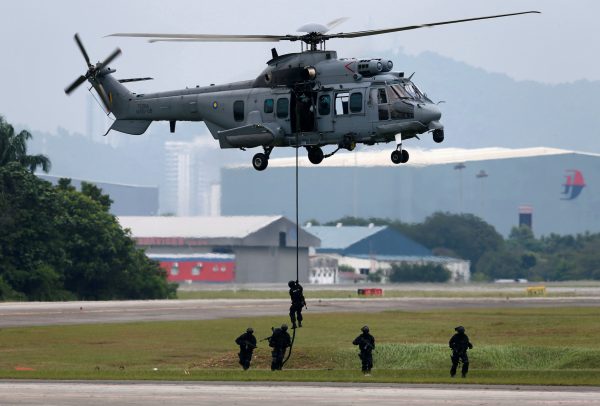Malaysia needs to ensure RMAF assets are not obsolete and that the operational readiness of all assets is maintained at an optimal level. But the RMAF’s ability to discharge its mission is limited by budget constraints. Since 2010, Malaysia has seen a downward trend in defence expenditure, which saw its share of GDP decreased from 1.5 per cent in 2010 to 1 per cent in 2020.
In real terms, Malaysia’s defence budget has fallen from a peak of US$4.6 billion in 2015 to US$3.8 billion in 2020. As a result, the budget allocated for operating expenditure fell by around 11 per cent from US$3.42 billion while development expenditure fell to below US$800 million during the same period. This situation means that the RMAF could not modernise its assets promptly and ensure the operational readiness of its current assets.
The RMAF has an estimated 71 combat aircraft in its inventory, ranging from F/A-18D Hornets, Mig-29N, Sukhoi-30 MKM, Hawk MK-108/MK-208 and MB-339C combat aircraft. The Hornets and Hawks were acquired in the mid-1990s, while the Sukhois were delivered to the RMAF between 2007 and 2009. The Mig-29s have been retired from service in phases since 2009. The first attempt to find suitable replacements was the Multi-Role Combat Aircraft program. But budget constraints led Malaysia to suspend the program in 2017.
The RMAF’s efforts to modernise its fleet of transport helicopters is proceeding slowly. It was only in late 2020 that the RMAF announced it would retire within the next few years its fleet of Sikorsky S-61A-4 NURI helicopters — in service for more than 50 years. There is no plan to acquire newer platforms, with the RMAF considering leasing several helicopters as an interim measure.
Furthermore, insufficient financial resources have impacted the RMAF’s ability to maintain its current assets. In the 13 years leading up to 2019, the RMAF’s yearly operating budget increased by a mere 3 per cent to an estimated US$600 million. In 2018–2019, the Malaysian government allocated the financial resources to meet only 47 per cent of the RMAF’s logistics expenditures.
As a result, maintenance works on existing assets had to be reduced or could not be carried out at all. A case in point is the operational readiness of the Sukhoi combat aircraft. In 2018, only four of the Sukhois could fly. As of 2021, it is reported that the RMAF has 43 combat capable aircraft.
Despite the financial challenges, the RMAF has taken measures to enhance its capabilities. It is addressing the maintenance issues, with the Sukhois currently undergoing a major refurbishment program domestically to extend their operational lifespan.
There are plans to acquire new platforms for the RMAF under the RMAF Capability Development Plan 2055 (CAP55), launched in 2018. The program is balancing the need to maintain the RMAF’s capabilities with financial constraints. For example, the RMAF plans to reduce its combat platform from five to two, a strategic move that will reduce operating costs in the long run.
The RMAF is currently focused on acquiring new platforms under the light combat aircraft program to replace the Hawk, MB-339 and Mig-29 platforms. On 22 June this year, the Malaysian Defence Ministry launched a tender for the program. The light combat aircraft is expected to address a wide variety of threats, from conventional to insurgencies. These expectations are consistent with the 2019 Malaysian Defence White Paper, which states the need to enhance Malaysia’s air defence and air strike capability.
Given Malaysia’s budget constraints, it will be tempting for defence planners to choose a light combat aircraft platform based primarily on acquisition costs, which they have done previously. For example, the acquisitions of the Migs and Sukhois from Russia were paid partly through barter trade.
But policymakers should also consider other costs in determining the appropriate light combat aircraft platform. A possible alternative approach is to adopt a Total Ownership Cost concept for the new platforms to operate at the optimal level in the long run, which would include the development, personnel, training, and logistical support costs.
This approach will provide a clearer picture of the new asset’s running costs and lead to a well-informed decision on which platform to acquire so that the RMAF can execute its mission in the long run.
Abdul Rahman Yaacob is a PhD candidate at the National Security College, The Australian National University.

